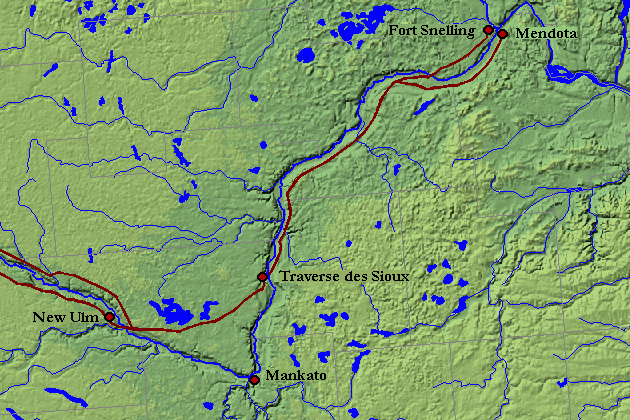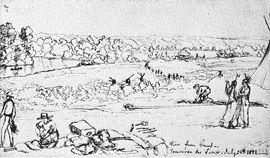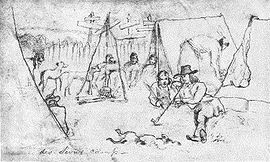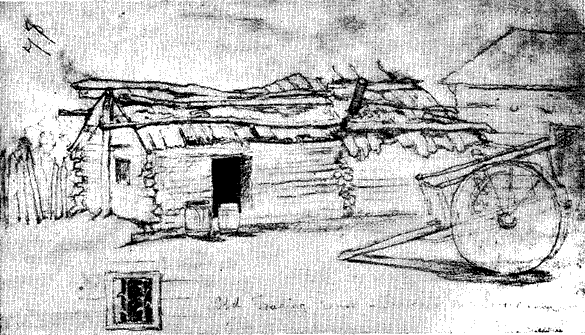
Traverse des Sioux
Encyclopedia
Traverse des Sioux is a historic site in the U.S. state
of Minnesota
. Once part of a preindustrial trade route, it commemorates that route, a busy river crossing on it, a nineteenth century settlement, trading post, and mission at that crossing place, a transshipment
point for pelts in fur trading
days, and an important treaty with Native Americans
which dispossessed the Dakota people
of part of their homeland and opened up much of southern Minnesota to white settlement.
Formerly a Minnesota state park, the site of the old settlement and river ford is now a State Historic Site and a Minnesota State Monument, and is on the National Register of Historic Places
. Traverse des Sioux is located in Nicollet County, Minnesota
on the Minnesota River
, just north of the city of St. Peter
.
 Traverse is a French word that means crossing, and some sources state that its use in the name refers to the crossing of the Minnesota River at this location. At least one scholarly source however states that Traverse des Sioux is named for the transit of the prairie to the west, and not for the river crossing. As used by the French Canadian
Traverse is a French word that means crossing, and some sources state that its use in the name refers to the crossing of the Minnesota River at this location. At least one scholarly source however states that Traverse des Sioux is named for the transit of the prairie to the west, and not for the river crossing. As used by the French Canadian
voyageurs and their Métis
relatives and descendants, a traverse was a crossing from a safe resting place across an open area to another point of shelter, such as a voyageurs’ crossing of hazardous waters from point to point rather than along a sheltered shore, or its correlate on land, a crossing by Métis ox cart brigades of open prairie from one secure resting place to another. The settlement at Traverse des Sioux was a destination of Métis carters during the days of the Red River Trails
, and was also home of a voyageur community during the same time.
Nineteenth century explorer John C. Frémont
used the term Traverse des Sioux to refer to the transit across the plain west of the river. Westbound travelers left the Minnesota River at the settlement of Traverse des Sioux and went directly west across the open prairie, leaving the shelter of the wooded riverbank in order to shortcut the right-angle elbow of the river at Mankato
. They returned to the river near the mouth of the Cottonwood River
at modern New Ulm
.

 A ford
A ford
of the Minnesota River existed from Pre-contact times. A trading post at the site of the crossing likely existed in the last half of the eighteenth century, and a number of fur traders had establishments there in the first half of the nineteenth century. An Indian mission was established there in 1843, and by 1851 the settlement had two missionaries and their families, a school, several fur trading establishments, a few cabins of French voyageurs, and twenty to thirty Indian lodges. By the 1840s it was used as a transshipment
point in the fur trade. Pelts from upstream fur posts and from collection points as far away as Pembina
and Fort Garry
, Canada
, were brought by ox cart trains traveling on the West Plains Trail, the westernmost of the Red River Trails
. At Traverse des Sioux the furs were transferred to flatboats bound for Mendota, Minnesota
and eastern markets. In the later part of that period some cart trains went all the way to Mendota or Saint Paul, Minnesota
, where the furs were taken by Mississippi riverboat to markets downriver.
In 1851 the Treaty of Traverse des Sioux
was signed at the post, by which tribes of the Sioux
people were induced to cede 24 million acres (97,000 km²) of land for seven cents per acre, opening up vast areas of Minnesota Territory
to non-native settlement. The lands surrendered including Minnesota west of the Mississippi and south of the lands of the Ojibway, all of what later became South Dakota
east of the Big Sioux River
, and much of northern Iowa.
After the treaty a town was platted, which kept the settlement's name. Its seventy buildings included two hotels, several churches, and five taverns. This town lost its position as county seat of Nicollet County in 1856, and soon was superseded by Saint Peter, the new seat a short distance to the south. The old town was abandoned by 1869.
 In 1905 a legislative commission was formed to identify the site of the 1851 treaty. Investigation located the spot, which was dedicated in 1914. Traverse des Sioux Treaty Site Park was established by legislative action, but little development occurred.
In 1905 a legislative commission was formed to identify the site of the 1851 treaty. Investigation located the spot, which was dedicated in 1914. Traverse des Sioux Treaty Site Park was established by legislative action, but little development occurred.
The park was reclassified as a state wayside park in 1937, and efforts were made to acquire additional land. By 1963 these efforts had stopped, and the site was inundated by the devastating 1965 floods of the Minnesota and Upper Mississippi Rivers. In 1969 however expansion was authorized, and the foundation ruins of the townsite were marked. In 1980 the wayside and townsite were removed from the state park system and transferred to the control of the Minnesota Historical Society
; the additional land went to the city of Saint Peter.
A self-guided tour of the town and treaty site is available, and the Nicollet County Historical Society maintains its headquarters at the adjacent Treaty Site History Center, with exhibits about the treaty and other area history.
In recent years historians have been able to locate the site of the river ford, and using an old map, have related it to the location of the fur post, cemetery, and other features of the old settlement. Archaeologists have also found Paleo-Indian projectile points estimated to be 9,000 years old, indicating the site was inhabited or visited by Native Americans for many millennia.
U.S. state
A U.S. state is any one of the 50 federated states of the United States of America that share sovereignty with the federal government. Because of this shared sovereignty, an American is a citizen both of the federal entity and of his or her state of domicile. Four states use the official title of...
of Minnesota
Minnesota
Minnesota is a U.S. state located in the Midwestern United States. The twelfth largest state of the U.S., it is the twenty-first most populous, with 5.3 million residents. Minnesota was carved out of the eastern half of the Minnesota Territory and admitted to the Union as the thirty-second state...
. Once part of a preindustrial trade route, it commemorates that route, a busy river crossing on it, a nineteenth century settlement, trading post, and mission at that crossing place, a transshipment
Transshipment
Transshipment or Transhipment is the shipment of goods or containers to an intermediate destination, and then from there to yet another destination....
point for pelts in fur trading
Fur trade
The fur trade is a worldwide industry dealing in the acquisition and sale of animal fur. Since the establishment of world market for in the early modern period furs of boreal, polar and cold temperate mammalian animals have been the most valued...
days, and an important treaty with Native Americans
Native Americans in the United States
Native Americans in the United States are the indigenous peoples in North America within the boundaries of the present-day continental United States, parts of Alaska, and the island state of Hawaii. They are composed of numerous, distinct tribes, states, and ethnic groups, many of which survive as...
which dispossessed the Dakota people
Sioux
The Sioux are Native American and First Nations people in North America. The term can refer to any ethnic group within the Great Sioux Nation or any of the nation's many language dialects...
of part of their homeland and opened up much of southern Minnesota to white settlement.
Formerly a Minnesota state park, the site of the old settlement and river ford is now a State Historic Site and a Minnesota State Monument, and is on the National Register of Historic Places
National Register of Historic Places
The National Register of Historic Places is the United States government's official list of districts, sites, buildings, structures, and objects deemed worthy of preservation...
. Traverse des Sioux is located in Nicollet County, Minnesota
Nicollet County, Minnesota
As of the census of 2000, there were 29,771 people, 10,642 households, and 7,311 families residing in the county. The population density was 66 people per square mile . There were 11,240 housing units at an average density of 25 per square mile...
on the Minnesota River
Minnesota River
The Minnesota River is a tributary of the Mississippi River, approximately 332 miles long, in the U.S. state of Minnesota. It drains a watershed of nearly , in Minnesota and about in South Dakota and Iowa....
, just north of the city of St. Peter
St. Peter, Minnesota
St. Peter is a city in Nicollet County, Minnesota, United States. The population was 11,196 at the 2010 census. It is the county seat of Nicollet County.St...
.
Name and location

French Canadian
French Canadian or Francophone Canadian, , generally refers to the descendents of French colonists who arrived in New France in the 17th and 18th centuries...
voyageurs and their Métis
Métis people (Canada)
The Métis are one of the Aboriginal peoples in Canada who trace their descent to mixed First Nations parentage. The term was historically a catch-all describing the offspring of any such union, but within generations the culture syncretised into what is today a distinct aboriginal group, with...
relatives and descendants, a traverse was a crossing from a safe resting place across an open area to another point of shelter, such as a voyageurs’ crossing of hazardous waters from point to point rather than along a sheltered shore, or its correlate on land, a crossing by Métis ox cart brigades of open prairie from one secure resting place to another. The settlement at Traverse des Sioux was a destination of Métis carters during the days of the Red River Trails
Red River Trails
The Red River Trails were a network of ox cart routes connecting the Red River Colony and Fort Garry in British North America with the head of navigation on the Mississippi River in the United States...
, and was also home of a voyageur community during the same time.
Nineteenth century explorer John C. Frémont
John C. Frémont
John Charles Frémont , was an American military officer, explorer, and the first candidate of the anti-slavery Republican Party for the office of President of the United States. During the 1840s, that era's penny press accorded Frémont the sobriquet The Pathfinder...
used the term Traverse des Sioux to refer to the transit across the plain west of the river. Westbound travelers left the Minnesota River at the settlement of Traverse des Sioux and went directly west across the open prairie, leaving the shelter of the wooded riverbank in order to shortcut the right-angle elbow of the river at Mankato
Mankato, Minnesota
Mankato is a city in Blue Earth, Nicollet, and Le Sueur counties in the U.S. state of Minnesota. The population was 39,309 at the 2010 census, making it the fourth largest city in Minnesota outside of the Minneapolis-St. Paul metropolitan area. The county seat of Blue Earth County, it is located...
. They returned to the river near the mouth of the Cottonwood River
Cottonwood River (Minnesota)
The Cottonwood River is a tributary of the Minnesota River, 152 miles long, in southwestern Minnesota in the United States. Via the Minnesota River, it is part of the watershed of the Mississippi River, draining an area of in an agricultural region...
at modern New Ulm
New Ulm, Minnesota
New Ulm is a city in Brown County, Minnesota, United States. The population was 13,522 at the 2010 census. It is the county seat of Brown County....
.
History


Ford (crossing)
A ford is a shallow place with good footing where a river or stream may be crossed by wading or in a vehicle. A ford is mostly a natural phenomenon, in contrast to a low water crossing, which is an artificial bridge that allows crossing a river or stream when water is low.The names of many towns...
of the Minnesota River existed from Pre-contact times. A trading post at the site of the crossing likely existed in the last half of the eighteenth century, and a number of fur traders had establishments there in the first half of the nineteenth century. An Indian mission was established there in 1843, and by 1851 the settlement had two missionaries and their families, a school, several fur trading establishments, a few cabins of French voyageurs, and twenty to thirty Indian lodges. By the 1840s it was used as a transshipment
Transshipment
Transshipment or Transhipment is the shipment of goods or containers to an intermediate destination, and then from there to yet another destination....
point in the fur trade. Pelts from upstream fur posts and from collection points as far away as Pembina
Pembina, North Dakota
Pembina is a city in Pembina County, North Dakota in the United States. The population was 592 at the 2010 census.The area of Pembina was long inhabited by various indigenous peoples...
and Fort Garry
Fort Garry
Fort Garry, also known as Upper Fort Garry, was a Hudson's Bay Company trading post at the confluence of the Red and Assiniboine rivers in what is now downtown Winnipeg. It was established in 1822 on or near the site of the North West Company's Fort Gibraltar. Fort Garry was named after Nicholas...
, Canada
Canada
Canada is a North American country consisting of ten provinces and three territories. Located in the northern part of the continent, it extends from the Atlantic Ocean in the east to the Pacific Ocean in the west, and northward into the Arctic Ocean...
, were brought by ox cart trains traveling on the West Plains Trail, the westernmost of the Red River Trails
Red River Trails
The Red River Trails were a network of ox cart routes connecting the Red River Colony and Fort Garry in British North America with the head of navigation on the Mississippi River in the United States...
. At Traverse des Sioux the furs were transferred to flatboats bound for Mendota, Minnesota
Mendota, Minnesota
Mendota is a city in Dakota County, Minnesota, United States. The name comes from the Dakota word for "where the waters meet." The population was 198 at the 2010 census.-History:...
and eastern markets. In the later part of that period some cart trains went all the way to Mendota or Saint Paul, Minnesota
Saint Paul, Minnesota
Saint Paul is the capital and second-most populous city of the U.S. state of Minnesota. The city lies mostly on the east bank of the Mississippi River in the area surrounding its point of confluence with the Minnesota River, and adjoins Minneapolis, the state's largest city...
, where the furs were taken by Mississippi riverboat to markets downriver.
In 1851 the Treaty of Traverse des Sioux
Treaty of Traverse des Sioux
The Treaty of Traverse des Sioux was a treaty signed on July 23, 1851, between the United States government and Sioux Indian bands in Minnesota Territory by which the Sioux ceded territory. The treaty was instigated by Alexander Ramsey, the first governor of Minnesota Territory, and Luke Lea,...
was signed at the post, by which tribes of the Sioux
Sioux
The Sioux are Native American and First Nations people in North America. The term can refer to any ethnic group within the Great Sioux Nation or any of the nation's many language dialects...
people were induced to cede 24 million acres (97,000 km²) of land for seven cents per acre, opening up vast areas of Minnesota Territory
Minnesota Territory
The Territory of Minnesota was an organized incorporated territory of the United States that existed from March 3, 1849, until May 11, 1858, when the eastern portion of the territory was admitted to the Union as the State of Minnesota.-History:...
to non-native settlement. The lands surrendered including Minnesota west of the Mississippi and south of the lands of the Ojibway, all of what later became South Dakota
South Dakota
South Dakota is a state located in the Midwestern region of the United States. It is named after the Lakota and Dakota Sioux American Indian tribes. Once a part of Dakota Territory, South Dakota became a state on November 2, 1889. The state has an area of and an estimated population of just over...
east of the Big Sioux River
Big Sioux River
The Big Sioux River is a tributary of the Missouri River, long, in eastern South Dakota and northwestern Iowa in the United States. The United States Board on Geographic Names settled on "Big Sioux River" as the stream's name in 1961....
, and much of northern Iowa.
After the treaty a town was platted, which kept the settlement's name. Its seventy buildings included two hotels, several churches, and five taverns. This town lost its position as county seat of Nicollet County in 1856, and soon was superseded by Saint Peter, the new seat a short distance to the south. The old town was abandoned by 1869.
Preservation

The park was reclassified as a state wayside park in 1937, and efforts were made to acquire additional land. By 1963 these efforts had stopped, and the site was inundated by the devastating 1965 floods of the Minnesota and Upper Mississippi Rivers. In 1969 however expansion was authorized, and the foundation ruins of the townsite were marked. In 1980 the wayside and townsite were removed from the state park system and transferred to the control of the Minnesota Historical Society
Minnesota Historical Society
The Minnesota Historical Society is a private, non-profit educational and cultural institution dedicated to preserving the history of the U.S. state of Minnesota. It was founded by the territorial legislature in 1849, almost a decade before statehood. The Society is named in the Minnesota...
; the additional land went to the city of Saint Peter.
A self-guided tour of the town and treaty site is available, and the Nicollet County Historical Society maintains its headquarters at the adjacent Treaty Site History Center, with exhibits about the treaty and other area history.
In recent years historians have been able to locate the site of the river ford, and using an old map, have related it to the location of the fur post, cemetery, and other features of the old settlement. Archaeologists have also found Paleo-Indian projectile points estimated to be 9,000 years old, indicating the site was inhabited or visited by Native Americans for many millennia.
External links
- Traverse des Sioux - official site

